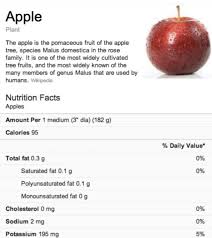Food information all over the place
Posted: August 14, 2013 Filed under: Food, Information, Nutrition claims Leave a comment » Food information services by Google
Food information services by Google
Recently, Google added nutritional information into its search functionality relating to more than 1,000 food items ranking from fruits to vegetables and from meats to complete meals. The new functionality is a part of Google’s Knowledge Graph that was launched in May 2012 in the US. Knowledge Graph is a database interconnecting various search results in order to enhance understanding. By offering information in this way, Google aims developing its information engine into a knowledge engine. As to food information, Google wants to help its users to make healthier choices – so it says. For examples how Google’s food information service will be operated, reference is made to its blogspot.
Food information in the EU
In the European Union, food information is considered to be of the essence as well. To that end, rules on food information were revamped under Regulation 1169/2011 (“the Regulation”) on the provision of food information to consumers . This Regulation will enter into force on 13 December 2014 and will bring about a great number of changes in the food information landscape in Europe. On the one hand, the Regulation aims to ensure a high level of protection of consumers’ health and interests by enabling them in making informed choices. On the other hand, the Regulation aims to realise free movement of legally produced and marketed food. But how is this going to be achieved?
Fair information practices
Firstly, food information shall not be misleading (a) as to the characteristics of the food, (b) by attributing to the food effects or properties it does not possess, (c) by suggesting that the food possesses special characteristics when in fact all similar food possess such characteristics, (d) by suggesting the presence of a particular food or an ingredient, while in fact substitution with another food or ingredient occurred. It should be stressed that food information comprises all information about a food made available to a final consumer. So not only product labels, but also information published on company website, leaflets, advertisements etc.
Specific guidelines for mandatory information
Secondly, the Food Information Regulation provides specific guidelines for mandatory food information, such as the name of the food, the list of ingredients etc. These guidelines relate for instance to the legibility of this information, requiring a minimum font size of 1,2 mm for the x-height, defined in Annex IV to the Regulation. They also relate to the place where mandatory information is shown, requiring that such information appears directly on the package or on a label attached thereto, so not on a separate leaflet. In cases of distance selling, most of the mandatory information should be available before the purchase is concluded. i.e. it should clearly appear on the website where the food at stake is offered for sale. Furthermore, these guidelines cover language requirements, stipulating that mandatory information shall appear in a language easily understood by the consumers of the Member States where a food is marketed. For the Netherlands, this would clearly be Dutch, but the Member States also have the authority to stipulate that the particulars shall be given in one or more languages of the official languages of the European Union. Such language could be used as an alternative but also in addition to the national language.
Nutrition declarations
Thirdly, nutrition declarations have become mandatory under the Regulation. Such declarations shall imperatively include the following seven elements contained in the food product: (1) energy value, (2) amounts of fat, (3) amounts of saturates, (4) amounts of carbohydrates, (5) amount of sugar, (6) amount of proteins and (7) amounts of salt. Furthermore, they may be supplemented with another six elements such as starch and fibre. The nutrition declaration should come in the form of a table, if space permits, and may be placed on the side or on the back of a packaging (not necessarily at the front side). The information provided must be given per 100 mg or 100 ml – only in addition thereto, information per portion can be given, provided that the portion is quantified. In order to indicate reference intakes of food ingredients, quite often the term GDA (Guideline Daily Amount) is used. This is not a requirement under the Regulation, but if used, this should be done in a way consistent with the Regulation. For vitamins and minerals, it is mandatory however to use the term RDA (Recommended Daily Amount).
Conclusion
The Food Information Regulation brings about such important modifications for food information, that it is very likely that the packaging of most of the products marketed in Europe needs to be adjusted. The nutrition declarations that Google intends to publish for various foods are just one element of those modifications. It is thereby ironic that in an attempt to harmonize the rules on food information, the Food Information Regulation in the same time creates barriers to EU-wide trade, by means of the language requirements for food information. Furthermore, even if the Regulation regulates food information in great detail (e.g. font prescribed font size), it is questionable whether that framework will work for B2B transactions or in cases where the food is not sold to final consumers (e.g. mass caterers). This is certainly food for further thought. Stay tuned to FoodHealthLegal!
